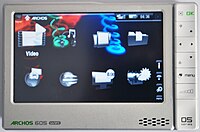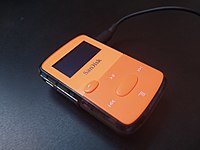
Back पोर्टेबल मीडिया प्लेयर ANP Партатыўны медыяпрайгравальнік Byelorussian বহনযোগ্য মিডিয়া প্লেয়ার Bengali/Bangla Portable Media Player German Portebla plurmedia legilo Esperanto Reproductor multimedia digital Spanish Kaasaskantav meediamängija Estonian امپیتری پلیر Persian נגן מדיה נייד HE Hordozható médialejátszó Hungarian
A portable media player (PMP) or digital audio player (DAP) is a portable consumer electronics device capable of storing and playing digital media such as audio, images, and video files.[1][2] The data is typically stored on a compact disc (CD), Digital Versatile Disc (DVD), Blu-ray Disc (BD), flash memory, microdrive, SD cards or hard disk drive; most earlier PMPs used physical media, but modern players mostly use flash memory. In contrast, analogue portable audio players play music from non-digital media that use analogue media, such as cassette tapes or vinyl records.
Digital audio players (DAP) were often marketed as MP3 players even if they also supported other file formats and media types.[3][4] The PMP term was introduced later for devices that had additional capabilities such as video playback. Generally speaking, they are portable, employing internal or replaceable batteries, equipped with a 3.5 mm headphone jack which can be used for headphones or to connect to a boombox, shelf stereo system, or connect to car audio and home stereos wired or via a wireless connection such as Bluetooth. Some players also include radio tuners, voice recording and other features.
DAPs appeared in the late 1990s following the creation of the MP3 codec in Germany. MP3-playing devices were mostly pioneered by South Korean startups, who by 2002 would control the majority of global sales.[5] However the industry would eventually be defined by the popular Apple iPod.[6] In 2006, 20% of Americans owned a PMP, a figure strongly driven by the young; more than half (54%) of American teens owned one, as did 30% of young adults aged 18 to 34.[7] In 2007, 210 million PMPs were sold worldwide, worth US$19.5 billion.[8] In 2008, video-enabled players would overtake audio-only players.[9] Increasing sales of smartphones and tablet computers have led to a decline in sales of PMPs,[10][11] leading to most devices being phased out, such as the iPod Touch on May 10, 2022, though certain flagship devices like the Sony Walkman are still in production. Portable DVD and BD players are still manufactured.[12]
- ^ "What is DLNA". DLNA. Archived from the original on 10 September 2013.
- ^ What are the differences in DLNA device classes? Archived 19 January 2016 at the Wayback Machine What are the differences in DLNA device classes?
- ^ "Words to Avoid (or Use with Care) Because They Are Loaded or Confusing". GNU Operating System. Free Software Foundation, Inc. Archived from the original on 3 June 2013. Retrieved 8 July 2013.
Most support the patented MP3 codec, but not all. To call such players 'MP3 players' is not only confusing,... We suggest the terms 'digital audio player,' or simply 'audio player' if context permits.
- ^ The Difference Between an iPod and a MP3 Player Archived 8 October 2011 at the Wayback Machine. Webopedia.com. Retrieved 16 August 2013.
- ^ "Mp3プレーヤー「韓国天下」".
- ^ Dorozhin, Alexey (19 December 2006). "История Mpio" [History of Mpio] (in Russian). Retrieved 19 April 2022.
- ^ "Portable MP3 Player Ownership Reaches New High | Ipsos". Retrieved 21 December 2023.
- ^ Playing with Labour Rights: Music player and game console manufacturing in China FinnWatch, SACOM and SOMO
- ^ Cite error: The named reference
overtakewas invoked but never defined (see the help page). - ^ "Smartphones Heavily Decrease Sales of iPod, MP3 Players". Tom's Hardware. 30 December 2012.
- ^ Yu, Emily. "PMP needs to merge with cellphone, says Smartwork exec". EE Times Asia. Archived from the original on 23 April 2008. Retrieved 3 October 2007.
- ^ "Portable media players give North Koreans an illicit window on the world". The Guardian. 28 March 2015. Archived from the original on 6 April 2015. Retrieved 9 April 2015.


